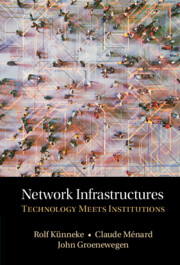Book contents
- Network Infrastructures
- Network Infrastructures
- Copyright page
- Dedication
- Contents
- Figures and Tables
- Preface
- Introduction
- Part I Conceptual Framework
- 1 Network Infrastructures
- 2 Institutional Embeddedness
- 3 Technology in Three Dimensions
- 4 Bringing Together Two Worlds Apart
- Part II Empirical Explorations
- Glossary
- References
- Index of Names
- Subject Index
1 - Network Infrastructures
From Coordination to Alignment
from Part I - Conceptual Framework
Published online by Cambridge University Press: 02 December 2021
- Network Infrastructures
- Network Infrastructures
- Copyright page
- Dedication
- Contents
- Figures and Tables
- Preface
- Introduction
- Part I Conceptual Framework
- 1 Network Infrastructures
- 2 Institutional Embeddedness
- 3 Technology in Three Dimensions
- 4 Bringing Together Two Worlds Apart
- Part II Empirical Explorations
- Glossary
- References
- Index of Names
- Subject Index
Summary
In this chapter, we specify the nature of network infrastructures from our alignment perspective. We first pay attention to the expected services that network infrastructures intend to provide: they are the backbones of the economy and deliver services essential to its citizens. We show how the infrastructures and the services they are expected to deliver are embedded in societal values. We then discuss the two dimensions of network infrastructures, the technological and the institutional dimensions, and analyze the characteristic of complementarity that underlies their components. Complementarities require tight coordination. Furthermore, we discuss in this chapter the core of our argument: the modalities providing technological coordination, on the one hand, and institutional coordination, on the other hand, should be well aligned; otherwise, the fulfillment of critical functions is endangered. We need to better understand how network infrastructures operate and under which conditions they can achieve the expected performance. We focus on the interdependencies between the technological and the institutional dimensions; on the critical functions as requirements for the system to provide the expected services; and on the necessity to align the coordination arrangements in both dimensions, in order to fulfill these critical functions. Otherwise, expected services cannot be delivered.
Keywords
- Type
- Chapter
- Information
- Network InfrastructuresTechnology meets Institutions, pp. 15 - 42Publisher: Cambridge University PressPrint publication year: 2021

